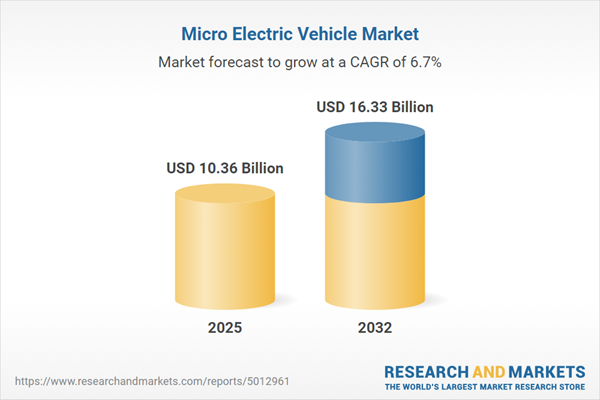Speak directly to the analyst to clarify any post sales queries you may have.
The micro electric vehicle market is rapidly evolving as urbanization, environmental demands, and policy incentives align, positioning these vehicles as integral to next-generation urban mobility solutions.
Market Snapshot: Micro Electric Vehicle Market Growth Trajectory
The Micro Electric Vehicle Market grew from USD 9.75 billion in 2024 to USD 10.36 billion in 2025. Projected to expand at a CAGR of 6.65%, the sector is expected to reach USD 16.33 billion by 2032. This growth is propelled by expanding last-mile transportation solutions, technology advancements, and supportive global regulatory frameworks, making the market increasingly relevant to companies prioritizing sustainability and cost efficiency.
Scope & Segmentation
- Vehicle Types: Four-wheelers; three-wheelers including cargo-focused units and passenger e-rickshaws
- Power Source: Battery electric vehicles (BEVs); hybrid electric vehicles (HEVs); plug-in hybrid electric vehicles (PHEVs)
- Charging Type: Fast charging; standard charging; swappable battery systems for fleet operations
- Charging Infrastructure: Home charging systems; public charging stations
- Application: Commercial use (last-mile delivery, logistics, tourism), institutional use (airports, campuses, industrial complexes), personal use
- End User: Fleet operators (B2B), government and municipal services, individuals (B2C)
- Regional Coverage: Americas (United States, Canada, Mexico, Brazil, Argentina, Chile, Colombia, Peru), Europe, Middle East & Africa (United Kingdom, Germany, France, Russia, Italy, Spain, Netherlands, Sweden, Poland, Switzerland, United Arab Emirates, Saudi Arabia, Qatar, Turkey, Israel, South Africa, Nigeria, Egypt, Kenya), Asia-Pacific (China, India, Japan, Australia, South Korea, Indonesia, Thailand, Malaysia, Singapore, Taiwan)
- Key Companies: Alkè s.r.l., CITROËN by Stellantis NV, Club Car, Cricket Mini Golf Carts, Inc., Daimler AG, Dongguan Excar Electric Vehicle Co., Ltd, Eli Electric Vehicles, General Motors Company, Guangdong Lvtong New Energy Electric Vehicle Technology Co., LTD., Hyundai Motor Company, ICON Electric Vehicles, Italcar Industrial S.r.l., Luvly AB, Marshell Green Power Co. Ltd, MELEX Sp. z o.o., Microlino AG, PMV Electric Pvt. Ltd., Renault Group, Shandong Shifeng (Group) Co., Ltd., Textron Inc., Toyota Motor Corporation, Waev Inc., Wings EV Private Limited, Wink Motors Inc., Yamaha Motor Co., Ltd.
Key Takeaways for Senior Decision-Makers
- Micro electric vehicles are a solution for dense urban spaces, enabling fleet operators and municipalities to meet sustainability objectives and address last-mile transportation challenges.
- Major automakers and innovative startups are focusing on modular vehicle platforms, battery partnerships, and digital fleet management systems to drive competitive differentiation.
- Policy incentives and infrastructure investments are advancing adoption, while business models such as mobility-as-a-service and subscription offerings are reshaping fleet and consumer usage patterns.
- Supply chain adjustments due to recent tariff measures are compelling manufacturers to consider regionalized production and more robust supplier networks.
- Regional market dynamics demand tailored go-to-market strategies; successful participants prioritize local infrastructure partnerships and segment-specific solutions.
Tariff Impact: Supply Chain and Pricing Adjustments
The introduction of new United States tariff measures in 2025 has prompted notable changes in sourcing and pricing across the micro electric vehicle value chain. Manufacturers are re-evaluating supplier agreements and shifting production to regions with favorable trade terms to offset increased import duties on key components. This is intensifying competition and elevating the importance of alternative material sourcing and innovation-driven cost management for industry players seeking to uphold market share.
Methodology & Data Sources
This report utilizes a hybrid research framework, integrating primary interviews with industry leaders and secondary data from industry publications, government reports, and proprietary intelligence. Data triangulation and expert validation workshops guarantee analytical rigor. Segmentation analyses and scenario modeling were conducted to ensure actionable, verified insights on the micro electric vehicle market and its evolving trends.
Why This Report Matters
- Pinpoints emerging opportunities and evolving risks, allowing business leaders to proactively align investments and partnerships in the micro electric vehicle sector.
- Delivers actionable intelligence on key segments, competitor strategies, and regional growth patterns to inform better market entry and expansion decisions.
- Clarifies how policy and technology shifts will shape supply chains, customer preferences, and successful business models—supporting resilient and profitable strategies.
Conclusion
Senior executives can leverage this report to identify growth arenas and competitive strategies in micro electric mobility. By aligning with technology trends, policy frameworks, and region-specific dynamics, stakeholders can maximize returns and accelerate sustainable urban transport adoption.
Additional Product Information:
- Purchase of this report includes 1 year online access with quarterly updates.
- This report can be updated on request. Please contact our Customer Experience team using the Ask a Question widget on our website.
Table of Contents
3. Executive Summary
4. Market Overview
7. Cumulative Impact of Artificial Intelligence 2025
Companies Mentioned
The companies profiled in this Micro Electric Vehicle market report include:- Alkè s.r.l.
- CITROËN by Stellantis NV
- Club Car
- Cricket Mini Golf Carts, Inc.
- Daimler AG
- Dongguan Excar Electric Vehicle Co., Ltd
- Eli Electric Vehicles
- General Motors Company
- Guangdong Lvtong New Energy Electric Vehicle Technology Co., LTD.
- Hyundai Motor Company
- ICON Electric Vehicles
- Italcar Industrial S.r.l.,
- Luvly AB
- Marshell Green Power Co. Ltd
- MELEX Sp. z o.o.
- Microlino AG
- PMV Electric Pvt. Ltd.
- Renault Group
- Shandong Shifeng (Group) Co., Ltd.
- Textron Inc.
- Toyota Motor Corporation
- Waev Inc.
- Wings EV Private Limited
- Wink Motors Inc.
- Yamaha Motor Co., Ltd.
Table Information
| Report Attribute | Details |
|---|---|
| No. of Pages | 183 |
| Published | November 2025 |
| Forecast Period | 2025 - 2032 |
| Estimated Market Value ( USD | $ 10.36 Billion |
| Forecasted Market Value ( USD | $ 16.33 Billion |
| Compound Annual Growth Rate | 6.6% |
| Regions Covered | Global |
| No. of Companies Mentioned | 26 |









